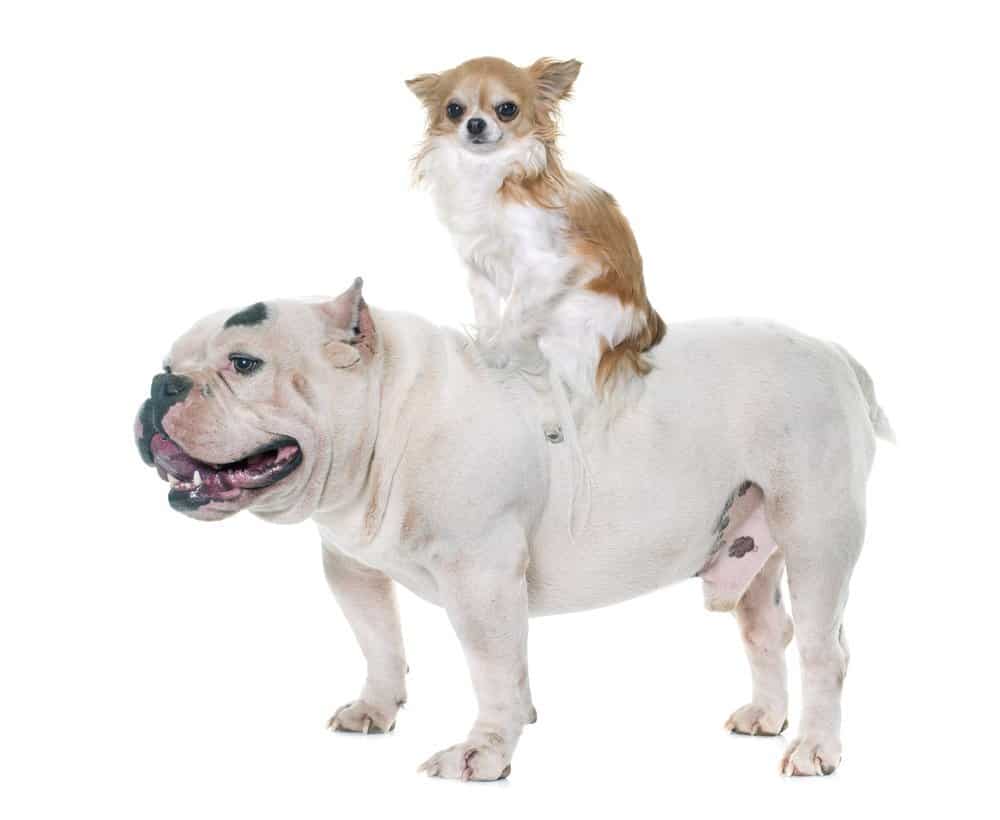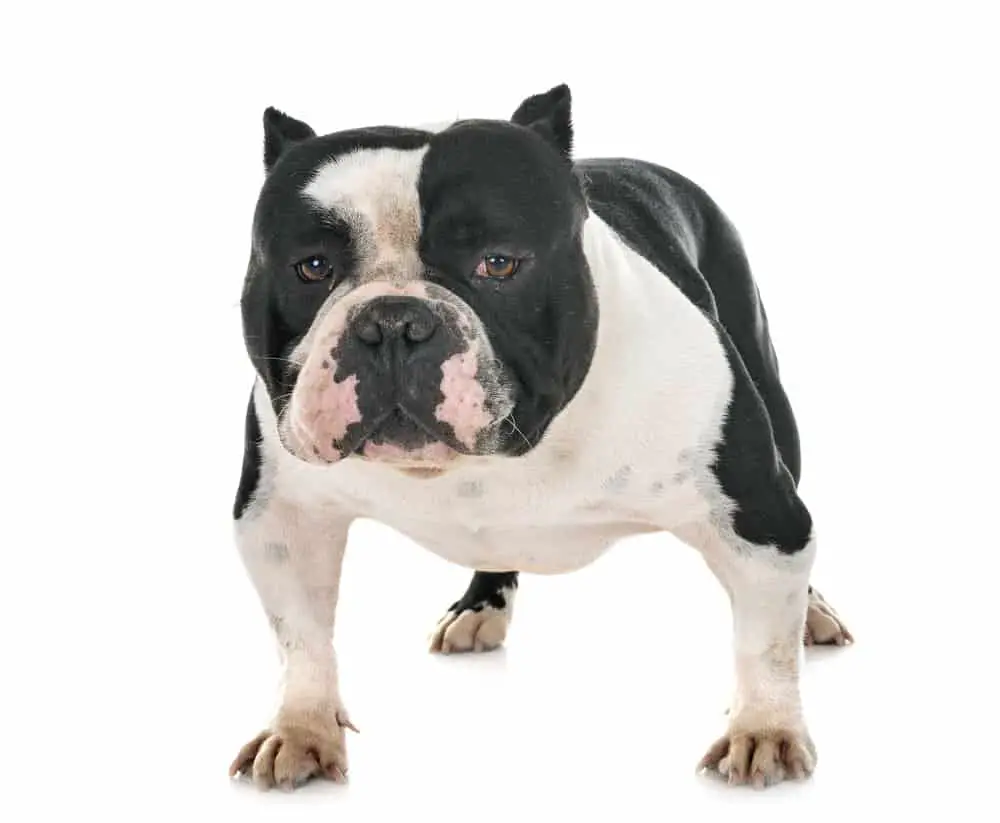The American Bully is a very new breed of dog and was first bred in the 1980s.
The sole purpose of the American Bully was to produce a friendly and affectionate family pet that had none of the potential negative traits of the American Pit Bull.
Other Names: Am. Bully, Bully
Country Of Origin: USA
Dog Group: N/A
Size: Small to large
Recommended For: Families, couples, single owners
Maintenance Level: Low/moderate
Lifespan: 8-12 years
Temperament: Friendly, affectionate, loyal
FAQ:
Good For the First-Time Owner: Yes
Good With Children: Yes
Good With Other Animals: Sometimes
Good With Strangers: Depends
Good For Apartments: No
Exercise Requirements: Daily walking
Can Live In Hot Weather: Yes
Can Live In Cold Weather: Yes
Can Tolerate Being Left Alone: Yes
Grooming: Low
Trainability: Easy/moderate
Breed Overview:

The American Bully comes in 4 sizes: pocket, standard, classic, and XL.
The only difference between any of these is the size, which is why they’re all classified under the American Bully breed.
This variation gives owners plenty of flexibility over living conditions and care routines.
Color: Any color except merle
Height: Pocket – 13-17 inches, Standard and Classic – 16-20 inches, XL – 19-23 inches
Weight: 66-120lbs
Personality and Temperament:

Although there are many different sizes, all American Bully dogs are known for having a friendly and affectionate temperament.
The purpose of the breed was to remove overly aggressive traits and prey drives, so these characteristics are considered serious faults in the breed.
American Bullies were bred solely as companion animals, meaning they thrive on human attention.
They make good family pets and are great with children, as this is their main purpose in life.
Even so, it’s wise to take an American Bully puppy to obedience classes to help with socialization and training.
While the breed isn’t known for being amazingly intelligent, obedience training isn’t too difficult.
This breed will pick up basic commands with ease, but owners might struggle with more complex ones.
However, almost any owners will be able to teach this dog the basic commands needed for a well-behaved dog.
As mentioned, the American Bully was purposely bred not to be aggressive, although many people mistake Bullies for their ancestor breeds.
A Bully dog will generally be fine around strangers when their owner is present, but it’s not uncommon for the dog to become protective and wary while at home.
For this reason, they make great alert dogs, and although not aggressive, most people will probably be very intimated by an American Bully.
 Similarly, American Bullies are generally fine around other animals, but early socialization is very important.
Similarly, American Bullies are generally fine around other animals, but early socialization is very important.
The typical prey instinct has been bred out of the American Bully, so owners should have a little problem with cats and other small pets.
However, it’ll be worth training puppies how to behave around animals to avoid any accidents.
The American Bully is a reasonably energetic breed, although exercise needs will realistically depend on the size of the dog.
For example, a Pocket American Bully won’t need as much exercise as an XL American Bully.
Either way, at least 30 minutes of daily exercise is needed, but this should be increased to at least an hour for larger dogs.
Similarly, American Bullies love to play, so make sure you spend some time throwing a ball for them, either at home or while out. Mental stimulation helps keep the dog happy too.
As a general rule, American Bullies shouldn’t be kept in apartments.
While this is mostly to do with the breed’s energy levels, it’s also because they’re very stocky dogs and benefit from having plenty of room to enjoy.
However, owners with plenty of space in their apartments should be fine to keep a Pocket American Bully, but it will need more exercise.
The American Bully is quite a good choice for first-time owners because they’re quite low maintenance dogs.
However, inexperienced owners must be aware the breed is very strong and needs confident owners to control them properly.
Providing a new owner is firm enough with training and gives the dog enough exercise; a Bully will be a great learner dog.
The breed was founded in America and was designed as a national family pet.
This means American Bullies are fine to be kept in both hot and cold climates.
However, their short coat and muscly bodies mean they benefit from extra protection in the winter, such as a winter coat in, particularly cold areas.
Although the American Bully is a very sociable animal, they can tolerate being left alone for more extended periods.
Owners will find they’re most successful if a routine is established early, and American Bullies benefit greatly from crate training.
Similarly, they’re much happier to be left alone if they have another dog to keep them company.
Grooming:
One of the best things about this breed is that it’s very easy to care for.
The breed has a short, stiff coat that sheds consistently throughout the year, although it’s never very much.
The best way to control this is with weekly grooming, ideally with a soft brush.
That said, grooming isn’t as crucial as it is with some other breeds, and owners could get away with monthly brushing.
The Bully’s short coat doesn’t benefit from regular bathing, mainly because this will dry the dog’s skin out.
Bathing should be saved for when necessary, and most problems can be solved with a good brushing.
One of the most important things to know about this dog is the special diet it requires.
Bullys are very muscly and so need much more protein than normal dogs. The breed works very well on a raw food diet, but if using conventional dog food, be sure to supplement it with extra protein.
Common Diseases and Conditions:
There isn’t much-sold information about hereditary conditions within the American Bully breed, mainly because it’s still so young.
Owners have reported a wide range of conditions, and very few seem to be consistent.
What’s more, many conditions seem to vary depending on the size of the dog, as this has some impact on genetic makeup.
The biggest red flags at the moment are hip and eye conditions, which are common in all purebred dogs.
However, testing isn’t done on a breeding stock like with more traditional breeds, so, for now, owners will have to take a risk on these conditions arising.
History:
The history of the American Bully is currently quite short.
The breed was established in the USA in the 1980s using American Pit Bull Terriers and American Staffordshire Terriers, which were then combined with different bulldog breeds.
The main purpose of doing this was to create a breed for lovers of Pit Bulls and Staffies that didn’t have any of the potentially aggressive traits these breeds had developed a reputation for.
Whether true or not, the American Bully is specifically bred to be more docile and affectionate than its ancestor breeds.
The genetic makeup of the American Bully varies between kennels, but it’s widely believed that the other breeds introduced include French Bulldog, American Bulldog, English Bulldog, and Olde English Bulldogge. However, some kennels maintain that they only use the two original breeds.
The American Bully currently isn’t recognized by major national kennel clubs, but this is mainly because most of them don’t recognize one or both of the ancestor breeds.
The Bully is first recognized by the American Bully Kennel Club, in 2004
and by the United Kennel Club on July 15, 2013
The current breed standard is quite vague in terms of weight allowance but was created to give owners criteria to breed to.
These breed standards are being updated as the breed becomes more established, but this is again because it’s so young.
Most importantly, the American Bully is known for its muscly body, which is much stockier than either of its parent breeds.
The introduction of so many bulldog breeds means there’s still quite a lot of variation within the American Bully breed, but this is becoming more streamlined.
American Bully Facts & Figures:
Did You Know?
- Along with the four recognized types, there are also several other smaller or larger types of American Bully. One is the Micro, but the ABKC doesn’t recognize this.
- Expect to pay a tidy price for an American Bully. They cost anywhere up to 5,000 USD.
- Although they’re often confused for Pit Bulls, there are many physical differences. For example, the American Bully is generally shorter, stockier, has a bigger head, and has smaller ears.
- One American Bully puppy, White Rhino, sold for 250,000 USD! He was considered a particularly good example of the breed.
- American Bullies eat a lot more than most other dogs. If you plan on getting one, be prepared for an expensive food bill!
- All American Bullies are classified as Standard until the age of 1. It’s only then that they reach full height, which is then used to classify them properly.
- The American Bully is currently recognized by the United Kennel Club and has been since 2013.
- The American Bully is an excellent companion pet because it’ll be really energetic when out walking, but also loves to have a sleep with its owner.

